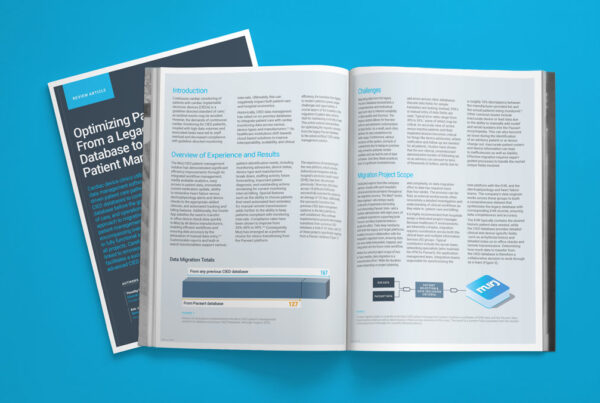When a cardiac device clinic decides to move from a legacy, on-premises system like PaceArt to a modern, cloud-based CIED patient management platform, the focus is often on the new technology’s potential to improve operational efficiency, clinic financials, and patient care. While these are the essential goals of any migration, a smooth transition hinges on one critical, often-overlooked factor: cardiac data management.
The reality is that data quality in legacy systems like PaceArt is poor, with typical error rates ranging from 30 to 50 percent1, some of which may be critical. Migrating this data without a systematic approach means you’re simply transferring old problems to a new system.
Bad data doesn’t just slow your team down—it can compromise patient outcomes and efficiency. Moving to a new system is the ideal opportunity for a fresh start. A clean data migration to a superior CIED patient management solution is the path to achieving clarity, operational efficiency, and clinical confidence from day one.
The root causes of bad cardiac data
Data quality in cardiac monitoring often suffers because legacy systems like PaceArt were not designed for the rigors of modern care. These platforms contribute to data migration challenges because they:
- Allow for inconsistency – Legacy systems allow for free-text entries and extensive customization of data fields, leading to significant inconsistencies and errors across clinic databases.
- Lack connectivity and updates – On-premises cardiac data management software does not benefit from systemic vendor updates, leading to out-of-date software.
- Rely on PDFs or manual entry – Discrete data fields for simple translation are often lacking; instead, they rely on PDFs or manual entry, which further introduces errors into datasets
The hidden impacts of bad cardiac data
Poor CIED data integrity can introduce severe operational, clinical, and financial risks. When data quality in cardiac monitoring suffers, it poses a direct threat to the continuity of patient care. We know that protecting patient safety is what truly keeps clinicians up at night, while data failures present critical operational and security concerns for IT teams.
- Operational burden: When data is messy, clinical teams spend hours trying to reconcile inaccurate device reports or patient rosters. This heavy lift brings up concerns about resource allocation, staff burnout, and more.
- Clinical risk: Inaccurate or missing records can create an incorrect view of active versus inactive patients and their implanted devices. This can lead to delayed or misdirected care and liability, especially during events like device advisories, where notification and follow-up are essential.
- Financial impact: Discrepancies in patient lists—such as a roughly 10 percent discrepancy between manufacturer-provided lists and the actual patients being monitored2—can contribute to the tens of thousands of dollars in unreimbursed administrative burden for following up on a single advisory.
- Increased liability: Unselectively transitioning all historic data, especially unnecessary, duplicative, or erroneous discoverable data, increases liability during audits and other reviews.
The fix: Clean migration as the foundation for confident care
Murj® has successfully led 127 former PaceArt clinics—encompassing over 440,000+ patients—to its cloud-based platform. The core of this success is a clean and selective historical patient data migration, along with our dedicated integration services professionals supporting customers every step of the way.
Data cleansing and selection
Our team systematically cleans the data by removing duplicates, correcting erroneous entries, and excluding patients who are no longer actively followed (like those who are deceased or lost to follow-up). This data cleansing in cardiac monitoring cuts down on unnecessary administrative costs.
Audit-ready data
The process synthesizes legacy PaceArt data with the clinic EHR system to build a comprehensive and accurate dataset. This selective data migration minimizes risk by removing extraneous or erroneous discoverable data, ensuring it will stand up to audits.
Clinical and technical expertise
The transition involves dedicated data experts—including a senior data engineer with nearly a decade of experience with PaceArt data—who ensure data is accurately interpreted, mapped, and integrated into future-state workflows.
Ultimately, historical patient data migration is not merely a technical movement of files; it is a clinical and operational imperative. Starting with a clean slate ensures a dramatically smoother go-live, providing your team with accurate historical records they can trust—the essential foundation for achieving better compliance and superior patient outcomes.
The practical benefits of a clean data start
The objective of cardiac data management software like Murj is to unlock the full potential of your new solution. By focusing on a clean, validated, and essential dataset, you gain:
Readiness from day one
Your team logs into a fully functional system with pre-populated patient records and ready-to-use workflows, with no manual entry required for current patients with discrete data available. Continuity of care is enabled by preserving monitoring intervals and real-time monitoring status.
Trust and efficiency
The opportunity for a fresh start with a cleaner, more accurate dataset can be missed by including more data than necessary. A database centered on current patients and relevant data enhances operational efficiency.
Improved compliance
Clinics transitioning to Murj have seen patient monitoring compliance rates improve from 30–40 to 90 percent3.
The full migration blueprint
Ultimately, the shift from a legacy system to a modern, cloud-based platform is about more than just technology; it’s about restoring trust, driving efficiency, and ensuring the highest level of patient monitoring compliance.
Murj’s data migration white paper provides the step-by-step methodology and best practices used to ensure your cardiac data migration from PaceArt delivers accuracy, compliance, and confidence from day one.
- Stivland TM, Johnson E, Allen MA, et al. Optimizing Patient Data Migration From a Legacy On-premise CIED Database to a Cloud-based Patient Management Platform. White paper. Murj; 2025.
- Mai W, Schwartz L, Kneeland C, et al. Impact of CIED Field Advisories: Unreimbursed Costs to Medical Systems. Circ Arrhythm Electrophysiol. 2023;16(6):e011764. doi:10.1161/CIRCEP.122.011764.
- Stivland et al., “Optimizing Patient Data Migration.”





